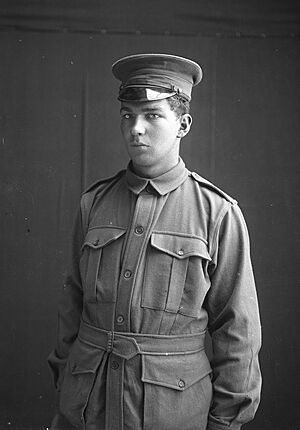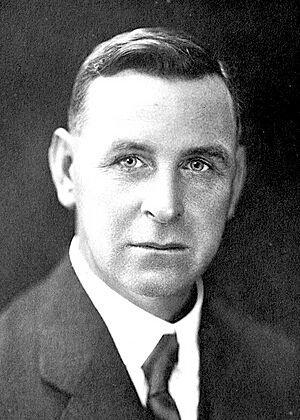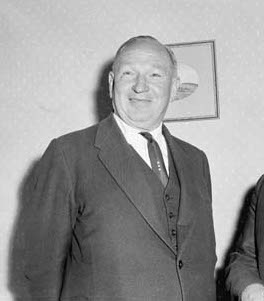Thomas Playford IV facts for kids
Quick facts for kids
The Honourable Sir
Thomas Playford IV
|
|
|---|---|
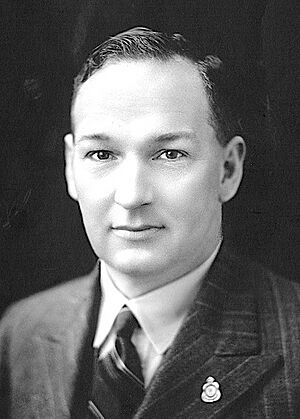
Playford c. 1938
|
|
| 33rd Premier of South Australia | |
| In office 5 November 1938 – 10 March 1965 |
|
| Monarch | George VI Elizabeth II |
| Governor | Lord Dugan Sir Malcolm Barclay-Harvey Lord Norrie Sir Robert George Sir Edric Bastyan |
| Preceded by | Richard Layton Butler |
| Succeeded by | Frank Walsh |
| Leader of the Opposition in South Australia | |
| In office 10 March 1965 – 13 July 1966 |
|
| Preceded by | Frank Walsh |
| Succeeded by | Steele Hall |
| Treasurer of South Australia | |
| In office 5 November 1938 – 10 March 1965 |
|
| Premier | Thomas Playford IV |
| Preceded by | Richard Layton Butler |
| Succeeded by | Frank Walsh |
| Leader of the Liberal and Country League | |
| In office 3 November 1938 – 13 July 1966 |
|
| Preceded by | Richard L. Butler |
| Succeeded by | Steele Hall |
| Member for Gumeracha | |
| In office 19 March 1938 – 2 March 1968 |
|
| Preceded by | Constituency Created |
| Succeeded by | Bryant Giles |
| Member for Murray | |
| In office 8 April 1933 – 19 March 1938 |
|
| Preceded by | Robert Hunter |
| Succeeded by | Constituency Abolished |
| Personal details | |
| Born | 5 July 1896 Norton Summit, South Australia, Australia |
| Died | 16 June 1981 (aged 84) Adelaide, South Australia, Australia |
| Political party | Liberal and Country League |
| Spouse | Lorna Playford (née Clark) |
| Children | 3 |
| Relatives | Thomas Playford II (grandfather) |
| Occupation | Orchardist |
| Profession | Politician |
| Military service | |
| Allegiance | Australia |
| Years of service | 1915–1919 |
| Rank | Lieutenant |
| Unit | 27th Battalion |
| Battles/wars | World War I, Gallipoli |
Sir Thomas Playford (born 5 July 1896 – died 16 June 1981) was a very important Australian politician. He was the Premier of South Australia and leader of the Liberal and Country League (LCL) political party for a long time. He served from 1938 to 1965, which is the longest time anyone has been a government leader in Australia.
During his time as Premier, South Australia grew a lot. More people moved there, and the economy became much stronger. Playford was known for always putting South Australia's interests first. He was very good at getting money from the Australian government for his state. His many election wins were helped by a special voting system called the "Playmander". This system gave more power to votes in country areas than in cities.
Contents
Early Life and Family
Thomas Playford was the third of four children in his family. He started school at Norton Summit School when he was six. It was a small school with one room and one teacher. Thomas was a good student but sometimes argued with his teacher. He was the first child there to be physically disciplined.
When he was 13, his father had an accident and broke his leg. Thomas asked to leave school to help run the family farm. He became very good at managing the farm, even after his father recovered. He also continued learning by joining local groups and taking part in debates in Adelaide. He even won an award for public speaking.
Serving in World War I
When World War I started in 1914, Playford wanted to join the army. His parents asked him to wait until he was almost 19. He joined the Australian Imperial Force in May 1915 as a private. He was part of the 27th Battalion.
He traveled to Egypt for training, then landed at Anzac Cove in Turkey in September 1915. After fighting in the Gallipoli campaign, his battalion moved to France in 1916. He was wounded in October and spent a year recovering in London. He had many operations to remove shrapnel from his body, and his hearing was permanently damaged. He returned to fight in Belgium and France in 1917.
After the war ended in 1918, Playford returned to South Australia in July 1919. He was honorably discharged as a lieutenant. He chose not to go to university, even though soldiers were offered free education. Instead, he went back to his family's cherry orchard. He also rejoined local clubs and groups.
Marriage and Children
Playford met his future wife, Lorna Clark, through relatives. They got engaged for three years before marrying on January 1, 1928. During their engagement, Playford built their new house on his farm mostly by himself. This house remained their home for their whole lives.
They had three children: Margaret (born 1930), Patricia (born 1936), and Thomas Playford V (born 1945). All his children went to private schools. His son, Thomas V, later became a minister of religion, just like some of his ancestors.
Beginning His Political Journey
Playford was a member of the local Liberal Federation. He didn't talk about becoming a politician until just before his first election. In 1932, the Liberal Federation joined with the Country Party to form the Liberal and Country League (LCL). This was done to stop the Labor Party from winning during the Great Depression.
Playford decided to run for election in the area of Murray in 1933. Many German families in the area supported him because his grandfather had helped them in the past. Playford was easily elected to the South Australian House of Assembly. The LCL formed the government with Richard Layton Butler as Premier.
A Backbencher's Voice
For the next five years, Playford was a backbencher, meaning he was a regular member of parliament, not a minister. He often spoke out against his own party's ministers and their policies. He was known for being very direct and sometimes rude. One historian said he was "unusually insolent and disloyal."
He believed strongly in "laissez faire" economics, which means the government should interfere very little in business. He even said, "It is not our business to worry whether people go broke or not." This was a surprising view during the Great Depression when many people needed government help. He also opposed government spending on big projects and tariffs (taxes on imported goods).
Despite his strong opinions, Playford was respected for how much research he did for his speeches.
The Playmander Voting System
During this time, new laws were made that Playford would later use as Premier. One important change was to the voting system. Since 1857, country areas had more voting power than cities. In 1936, this difference became even bigger. The new system meant that a vote in a country area was worth at least twice as much as a vote in a city.
Over the next 30 years, Adelaide's population grew much larger than the country areas. But the number of seats in parliament didn't change to match this. This meant country voters had six times more influence. This system was designed to keep the Labor Party out of power. It was later called the "Playmander" because it helped Playford stay in power for so long, even though he didn't create it.
Becoming Premier
After the 1938 election, Premier Butler offered Playford a job as a minister. Playford became the Commissioner of Crown Lands in March 1938. This was an attempt to make him less critical of the government.
In November 1938, Butler resigned to try for a federal seat. Playford was then chosen by his party to be the new leader of the LCL. This made him the 33rd Premier of South Australia. He also became the Treasurer. Many people thought he would only be Premier for a short time, but he stayed for almost 27 years.
When Playford became Premier, his party did not have a majority of seats. He had to work with many independent politicians. He managed to get their support by promising not to upset social conservatives and by threatening early elections, which independents usually didn't have the money to fight.
Leading During Wartime
Playford became a wartime Premier in 1939 when Australia joined World War II. As the war continued, Australia needed to make its own goods. Playford strongly argued that South Australia was the best place for new factories. He said it was far from the fighting and had skilled workers.
Many new factories were built in Adelaide and other towns. These included places for making ammunition and shipyards. Playford also approved a pipeline to bring water from the Murray River to Whyalla for the steelworks there. He had opposed this idea before becoming Premier, but he changed his mind to help the state grow.
Most of these factories were built by the government's Department of Manpower and the South Australian Housing Trust. After the war, some of these factories were changed for other uses. For example, an explosives factory became a research center for rockets.
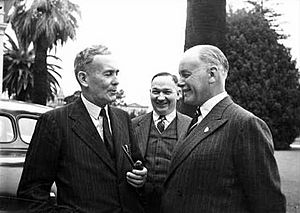
Playford had to work hard to get these projects done. He dealt with government workers and private companies. But his toughest negotiations were with the Australian government. He worked with seven different Prime Ministers during his time. Surprisingly, he got along best with Labor Prime Minister Ben Chifley and had a difficult relationship with his own party's leader, Robert Menzies.
Playford was very good at getting more money for South Australia than it was supposed to get. Prime Minister Menzies once said that Playford would "bully recalcitrant Prime Ministers" to get what he wanted for South Australia. Playford believed the federal government often took too much power from the states.
During the war, two state elections were held. In 1941, Playford's LCL won its first majority government. In 1942, voting became compulsory, which increased voter turnout. Playford won again in 1944, still with the help of the "Playmander" voting system.
Building South Australia's Industries
One big challenge for South Australia was its reliance on imported fuel. The main electricity company, Adelaide Electricity Supply Company (AESC), was slow to build up coal supplies. Playford wanted them to use brown coal from the Leigh Creek mine in South Australia to avoid problems. He pushed for the mine to be developed.
The AESC continued to resist Playford's ideas. After more conflicts, a special investigation in 1945 recommended that the AESC be taken over by the government. Playford's plan got a big boost when strikes in New South Wales caused power shutdowns in other states. South Australia, thanks to Leigh Creek, managed to avoid these problems.
In October 1945, Playford introduced a bill to take over the AESC and create the Electricity Trust of South Australia (ETSA). The Labor Party was surprised but supported the bill. However, the upper house of parliament, the Legislative Council, was against it. They believed in free enterprise and didn't want the government to control businesses.
After months of campaigning by Playford, the bill finally passed in April 1946. ETSA was formed and became very important for South Australia's growth after the war. This decision to nationalize the electricity company showed Playford's practical approach to economics. He put the state's development first, even if it went against his party's usual beliefs.
Economic Growth and Housing
During the economic boom after the war, Playford's government attracted businesses to South Australia in unique ways. They offered low or no business taxes, cheap electricity, land, and water. The South Australian Housing Trust would even build factories and homes for workers.
This helped create many new factories in Adelaide for making cars and other goods. Mining, steel, and shipbuilding industries also grew. Prices and wages were kept low to encourage more investment. This made South Australia very competitive.
The Housing Trust was key to Playford's plan. By providing affordable housing, workers could accept lower salaries, which kept production costs down for businesses. In 1940, Playford introduced a law to improve housing conditions and set limits on rents. This helped poor families and angered landlords who usually supported his party.
Playford's economic policies were sometimes called "socialism" by his own party members. But the Labor Party often supported him. The Labor leader, Mick O'Halloran, even said that Playford could do more for his voters than he could. Playford often had more arguments with his own party members in the upper house than with the Labor opposition.
Big projects were started, like building the city of Elizabeth in Adelaide's north. This city was built by the Housing Trust for workers at the Holden car factory. Playford also convinced Chrysler to expand its car manufacturing in Adelaide. By the time he left office, Holden and Chrysler employed about 11,000 people in South Australia.
Playford also wanted South Australia to be involved in uranium mining. He saw it as a way to get electricity and help the country during the Cold War. He invested government money in research and mining at Radium Hill. This project brought in a lot of money from the American government, who needed uranium for nuclear weapons.
By the time Playford left office in 1965, South Australia's population had almost doubled. Its economy had also grown significantly. Employment in manufacturing increased by 173% during his time. However, some people criticized him for relying too much on car manufacturing and not diversifying enough.
Challenges and Changing Times
In the 1950s, a young lawyer named Don Dunstan became a Labor member of parliament. Dunstan and Playford became the main rivals in parliament. Playford, who was used to working with Labor leaders, tried to build a relationship with Dunstan. He would even give Dunstan a ride home after late parliament sessions. They respected each other, but their political views were very different.
Even though the economy was booming, the LCL's share of votes slowly went down after 1941. The LCL rarely won more than 23 seats and was not very popular in Adelaide. They relied on the "Playmander" and support from smaller parties to stay in power.
The 1962 Election
In the 1962 election, the Labor Party won more votes than the LCL (54.3% to 45.7%). However, because of the "Playmander," Labor only won 19 seats, while the LCL won 18. Two independent politicians held the balance of power. It looked like Playford's long time as Premier might be over.
After a week, Playford announced he would not resign. The two independents decided to support Playford, allowing him to form a government for a 10th term. One independent even joined the LCL and became a minister. This election showed how unfair the "Playmander" had become, as a city vote was worth much less than a country vote.
Changing Expectations
Playford's economic success led to a growing middle class, including many immigrants. These people had different social expectations than Playford's traditional views. This made it harder for him to stay in power.
Playford was known for not spending much money on education. He thought it was less important than industrial growth. While university attendance tripled and school enrollments grew a lot, class sizes increased because there weren't enough teachers. Playford also didn't allow other languages to be taught in schools, saying "English is good enough."
Hospitals were often overcrowded during his rule. Playford also believed that charities, not the government, should help orphans and disadvantaged people. Spending on social welfare was lower than in other states.
Playford had little interest in the arts, calling them "frills not fundamentals." He was often criticized for this. However, as public interest in the arts grew, especially with the start of the Adelaide Festival, Playford finally agreed to fund the building of the Festival Centre in 1963.
His focus on development also led to concerns about protecting old buildings. Many historic houses in Adelaide were torn down for new office blocks. Playford supported these changes, saying the old buildings were "substandard."
People also became unhappy with strict laws on drinking, gambling, and police powers. Playford, who didn't drink, smoke, or gamble, had no interest in changing these laws. His own party members knew that if he didn't change, they would lose the next election.
Losing Power
Playford was confident going into the 1965 election. However, the Labor Party focused their efforts on specific areas where the population was growing. On election day, March 6, 1965, Labor won two key seats. The LCL lost power for the first time in 35 years.
Playford stayed up late to see the results and accepted defeat at midnight. He seemed calm when he told the public, but he cried when he told his family. He had been Premier for over 26 years.
After the loss, Playford continued to lead the LCL opposition for about a year and a half. He then stepped down as leader. Steele Hall took over and later led the LCL to victory in the next election, still with the "Playmander" in place. Playford retired from politics, saying he couldn't cope with the changes in attitudes of some politicians.
Later Life and Legacy
Playford retired from parliament with a pension. He was highly respected for his honesty and integrity. He never allowed his ministers to own shares in companies or sit on company boards to avoid conflicts of interest.
He returned to his orchard at Norton Summit. He continued to be interested in South Australian politics and privately advised Liberal politicians. He also remained friendly with Labor figures, even offering advice to their new ministers. In 1977, he was the only Liberal invited to Don Dunstan's 50th birthday party, where he socialized with other Labor leaders.
Playford also served on the boards of the Electricity Trust and the Housing Trust. He continued to be very careful with money, always pushing for cost-saving methods.
Playford had health problems after a heart attack in 1971. He died on June 16, 1981, after another heart attack. His funeral procession passed through thousands of people who came to pay their respects. He was buried in the Norton Summit cemetery, and his gravestone reads: 'a good man who did good things'.
Images for kids



